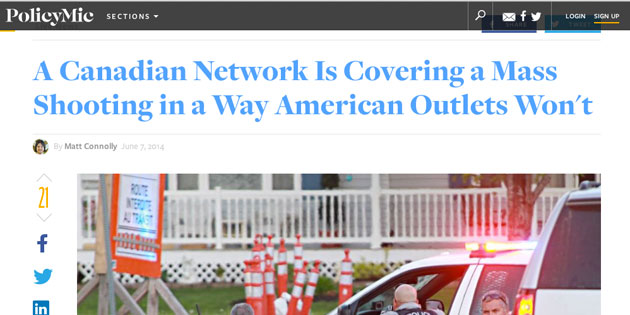Covering tragedy: Oregon shooting rekindles discussion of how and what to report
 This week the talk in the faculty room is, once again, about the latest school shooting. Perhaps the discussion about what happened at Reynolds High School in Oregon should carry over to the journalism classroom. It’s an opportunity to discuss the ethics of covering such tragedies. After this most recent shooting, this post came across my Facebook news feed: “A Canadian Network is Covering a Mass Shooting in a Way American Outlets Won’t.” The story was reported on policymic.com over the weekend, just days before the Oregon school shooting.
This week the talk in the faculty room is, once again, about the latest school shooting. Perhaps the discussion about what happened at Reynolds High School in Oregon should carry over to the journalism classroom. It’s an opportunity to discuss the ethics of covering such tragedies. After this most recent shooting, this post came across my Facebook news feed: “A Canadian Network is Covering a Mass Shooting in a Way American Outlets Won’t.” The story was reported on policymic.com over the weekend, just days before the Oregon school shooting.
According to the article, Sun News Network decided against showing the picture or revealing the name of a shooter who murdered three Royal Canadian Mounted Police officers in New Brunswick on June 4. The Canadian network’s rationale: “It’s easy to report on the life of the killer, to scour his deranged Facebook page, to speculate about motive, but doing so could actually encourage the perception that his heinous acts are somehow justified . . . In the media, it’s a dilemma. We feel an obligation to tell the public what is going on. Our job is to inform. And like the old saying goes, ‘if it bleeds, it leads.’. . . Let’s take an honest look in the mirror to see if our hyper-interest might be contributing to this very disturbing phenomenon. . . We will not help give this killer his blaze of glory.”
Sun News Network also questioned the ethics of turning these events into spectacles through social media: “Now, with wall-to-wall media coverage of these events, are we feeding future monsters? Are we putting ideas in their heads? When we make the killer’s name and face famous, are we setting the stage for future mass killings?”
The network’s position that mass shootings are contagious leads the policymic.com reporter to draw a comparison to media coverage of suicides. And that’s yet another unfortunate and sad discussion that we sometimes need to have with our students. The article links to the Surgeon General and other national health organizations’ guide for media coverage of suicides. Tips include how to interview surviving relatives and friends, what language to use and avoid, and which angles and stories to pursue. Another useful resource is the National Institute of Mental Health’s “Recommendations for Reporting on Suicide.” This website page provides suggestions for digital media reporters specifically.



